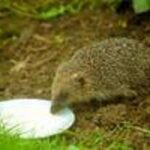The African Pygmy Hedgehog is a hybrid of the White-Bellied and North African hedgehog. Their backs are covered with rows of prickly spines (but not barbed like porcupines, and they don’t “shoot” their quills) and soft furry bellies, and come in a variety of colors and markings. They grow five to eight inches long and live three to eight years, but four to six years is their typical life span. African Pygmy Hedgehogs are non-aggressive and naturally shy creatures, and will curl into a ball when nervous or frightened. They can get used to being held but don’t really crave interaction with humans. Hedgehogs don’t care for being cuddled but may crawl all over you if you allow them to.
Buy a hedgehog that is six to eight weeks old from a reputable breeder and handle it often and gently. Cradle the hedgehog in your palm and he will unroll in a few minutes. The prickly spines will not be painful unless you let him curl around your finger! Let him lay in your lap while you watch TV or read. An older hedgehog from a pet store who has not been held much may be unfriendly. Put a heavy towel in the palm of your hand and hold him quietly for a few minutes at a time. With much patience, he may learn to accept handling.
A hedgehog will need a cage with three to four square feet of floor space. A rabbit cage or multi-level ferret cage will do nicely or you can use an aquarium. The floor should be solid, not wire, and covered with a one or two inch layer of wood shavings. Aspen is recommended, and kiln-dried pine will work, but avoid using cedar shavings. The aromatic oils in cedar can cause respiratory problems, possibly fatal ones. Some hedgehog owners have had good luck with Astro turf, taking it out and rinsing it off daily, or newsprint. You may have to try a few different things to see which works best for your hedgehog. Put in a small litter box with dust-free cat litter (not the clumping kind). They will want a covered “nest.”. A cardboard box with a hole cut in the side will do. Watch that they don’t eat the wood shavings or litter.
Being nocturnal animals, your pet will probably want to sleep when you are awake. Over time he may adapt his sleeping schedule to match yours with gradual changes in his feeding schedule. Hedgehogs are active creatures when they are awake, and a large exercise wheel will give them exercise and entertainment. The wheel should have at least and 11″ diameter, the sides should be open and the running surface of the wheel should be solid so they don’t catch their feet in it and harm themselves. Keep his cage in a warm place, around 72 degrees F and away from drafts. Hedgehogs have a low resistance to temperature changes. In the winter, you can place a reptile heating pad under part of the floor of the cage but leave part uncovered so he can move to a cooler spot if he gets too warm.
Many people will feed their hedgehog cat food but it is no longer recommended staple in their diet. There are specially prepared hedgehog diets which vary in quality. You may find them online easier that at your local pet supply store. Buy a high quality food for your pet’s optimum heath. Hedgehogs are insectivores (they eat an insect diet) but are not too particular. Supplement their diet with small amounts of boiled egg, fruits, baby rice cereal, beans, lean cooked chicken, and fresh (not canned) tuna or salmon. Give them a treat of one or two crickets or mealworms a day. Their diet should be high in protein and low in fat and iron. Change their diet gradually when necessary; hedgehogs resist sudden diet changes. Don’t overfeed your hedgehog; an obese hedgehog will have rolls of fat around his legs.
Only one hedgehog to a cage! Two hedgehogs in a cage may fight, even unto death. If you want to breed hedgehogs, put them together but keep a very close eye on them for the first day or two. Other pets in the family usually pose no threat to the hedgehog. His ball-rolling behavior with spiny quills poking out are his defense mechanism when he is frightened or nervous.
Hedgehogs have a very peculiar and alarming behavior called “self-annointing.” An unusual odor or substance may send them into contortions, and they will lick the substance and create a foamy saliva which they spread over their quills. No one is entirely sure why they do this; it may be that hedgehogs, who are resistant to toxins, are spreading toxins or smells over their body as a deterrent to predators.
These amiable little creatures make fun and unusual pets, but their specialized care requires that an adult, not a child or young teen, is the primary care giver for the pet. Be sure you are ready to take on this responsibility if you decided to get a hedgehog as a pet for your children.





